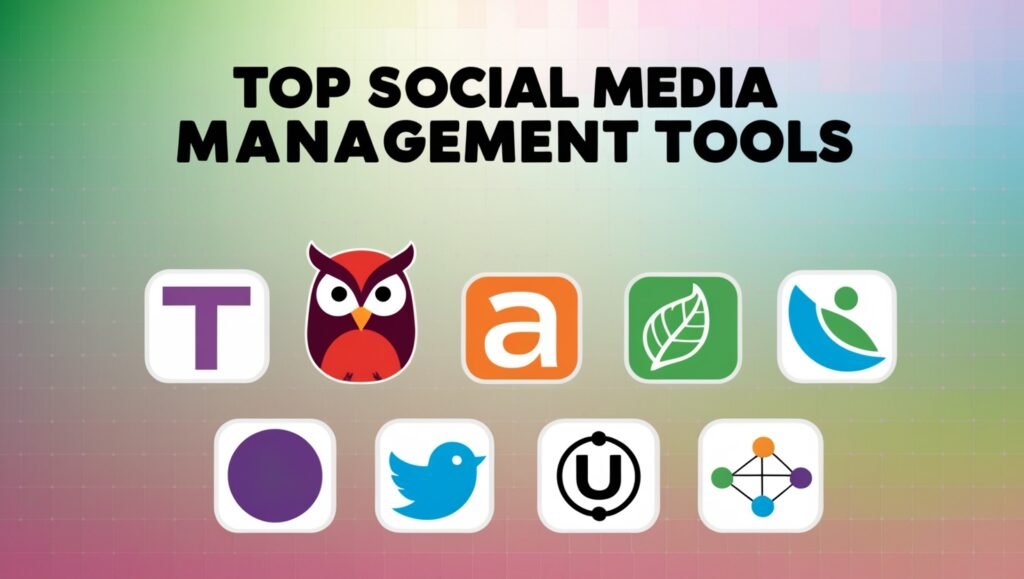
Introduction to Making Money Online
In today’s digital world, making money online is more accessible than ever. You can turn your skills and interests into a source of income from the comfort of your home. Whether you want to freelance, sell products, or manage social media, there are countless opportunities available. Here we also showing best free social media scheduler
You might wonder where to start or which tools to use. This article will guide you through the basics of online income. We’ll explore social media management, the best tools, and effective strategies that can help you succeed. By the end, you’ll have a clear roadmap to begin your journey. Let’s dive in and discover how you can make money online!
Understanding Social Media Management
Social media management is an important part of online business today. It involves creating, scheduling, and analysing content for various social media platforms. If you want to make money online, understanding how to manage social media is key.
What Is Social Media Management?
Social media management means handling a brand’s presence on platforms like Facebook, Instagram, Twitter, and LinkedIn. It includes posting updates, responding to comments, and engaging with your audience. You can build relationships with customers and grow your brand’s visibility online. This is essential for attracting new followers and potential customers.
Importance of Social Media in Online Business
Social media is a powerful tool for reaching people. You can connect with a large audience and share your message quickly. When you use social media effectively, you can increase your sales and brand awareness. Many businesses now rely on social media to drive traffic to their websites and convert visitors into customers.
You can also use social media to gather feedback from your audience. This helps you understand what your customers like and dislike. By knowing your audience, you can tailor your products and services to better meet their needs.
Why You Should Care
If you want to make money online, learning about social media management is vital. You can create engaging content that attracts more followers. This can lead to more sales and greater success. By mastering social media, you can build a strong online presence that helps you stand out from the competition.
In the next sections, we will explore how to choose the right tools for social media management and develop effective strategies to boost your online income. Let’s keep going!
Choosing the Right Tools

Selecting the right tools for social media management can make a big difference in your success. With so many options available, it can feel overwhelming. However, understanding what to look for will help you choose the best tools for your needs.
Key Features to Look For
1. User-Friendly Interface
You want tools that are easy to use. A simple interface allows you to navigate quickly and focus on creating content instead of getting stuck in complex settings.
2. Scheduling Capabilities
Look for tools that let you schedule posts in advance. This feature saves you time and helps you maintain a consistent online presence. You can plan your content for days or weeks ahead, ensuring that you stay active on social media even when you are busy.
3. Analytics and Reporting
Good tools provide insights into how your posts perform. You should be able to track likes, shares, comments, and engagement rates. These analytics help you understand what works and what doesn’t, allowing you to adjust your strategy accordingly.
4. Integration with Other Platforms
Choose tools that integrate well with other applications you use, such as email marketing or website analytics. This makes managing your online presence easier and more efficient.
5. Collaboration Features
If you work with a team, look for tools that offer collaboration options. This allows multiple users to work together, share ideas, and streamline the content creation process.
How to Evaluate and Select the Best Tools
To find the right tools, start by identifying your specific needs. Consider the platforms you want to focus on and the type of content you plan to create. Then, research and compare different tools. Read reviews, watch demo videos, and even try out free trials when available.
Ask yourself these questions:
- Does this tool meet my requirements?
- Is it easy to use?
- Does it provide the features I need for scheduling and analytics?
- How much does it cost, and does it fit my budget?
Taking the time to evaluate your options will pay off. By choosing the right tools, you can manage your social media more effectively and make the most of your online business efforts.
In the next section, we’ll look at some of the top social media management tools available in 2024. This will help you make informed choices for your online income journey.
Top Social Media Management Tools

With the right tools, you can streamline your social media management and boost your online presence. Here are some of the best social media management tools available in 2024. Each of these tools offers unique features to help you succeed.
1. Hootsuite
Overview: Hootsuite is one of the most popular social media management platforms. It allows you to manage multiple accounts from a single dashboard.
Key Features:
- Schedule posts for various platforms in advance.
- Monitor your social media feeds in real-time.
- Analyse performance with detailed reports.
Why You Should Consider It: Hootsuite is ideal for businesses of all sizes. Its user-friendly interface makes it easy to manage your social media strategy effectively.
2. Buffer
Overview: Buffer is known for its simplicity and focus on scheduling. It helps you plan and publish your content seamlessly.
Key Features:
- Schedule posts for multiple accounts.
- Analyse engagement metrics.
- Create a content calendar to stay organised.
Why You Should Consider It: If you want a straightforward tool that emphasises scheduling, Buffer is a great choice. It’s perfect for individuals and small businesses looking to maintain a consistent posting schedule.
3. Sprout Social
Overview: Sprout Social is a comprehensive tool designed for teams. It provides advanced features for collaboration and engagement.
Key Features:
- Team collaboration tools for managing projects.
- In-depth analytics to track performance.
- Customer engagement features, including social listening.
Why You Should Consider It: If you’re part of a larger team or manage multiple clients, Sprout Social can enhance your workflow and improve communication.
4. SocialPilot
Overview: SocialPilot is an affordable option that packs a punch. It offers a variety of features for both individuals and businesses.
Key Features:
- Schedule and publish posts across multiple platforms.
- Track performance with analytics.
- Integrate with various applications for streamlined management.
Why You Should Consider It: SocialPilot is great for budget-conscious users who still want a robust set of features.
5. Later
Overview: Later is focused on visual content, making it perfect for platforms like Instagram.
Key Features:
- Drag-and-drop calendar for easy scheduling.
- Visual content planning tools.
- Analytics to track post performance.
Why You Should Consider It: If your strategy involves a lot of visual content, Later can help you plan and manage your posts effectively.
6. Agorapulse
Overview: Agorapulse is an all-in-one solution for social media management. It combines scheduling, monitoring, and analytics in one platform.
Key Features:
- Schedule posts and monitor engagement.
- Manage comments and messages from one place.
- Detailed reporting for performance analysis.
Why You Should Consider It: Agorapulse is excellent for businesses that want a comprehensive tool to manage all aspects of their social media presence.
Choosing the right social media management tool can greatly impact your online income potential. Each of these tools offers unique features to help you manage your social media accounts more effectively. By selecting the right one for your needs, you can enhance your content strategy, engage with your audience, and ultimately boost your online success. In the next section, we will discuss strategies for effective social media marketing.
Strategies for Effective Social Media Marketing

To succeed in making money online, having a solid social media marketing strategy is essential. This section will cover key strategies to help you create engaging content, build a loyal following, and drive sales.
1. Define Your Target Audience
Understanding who your audience is will shape your social media efforts. Consider the following:
- Demographics: Age, gender, location, and interests.
- Behaviour: What platforms do they use? What content do they engage with?
You can use tools like surveys and social media analytics to gather insights about your audience. Knowing your target audience will help you create content that resonates with them.
2. Create Engaging Content
The content you post is crucial for attracting and retaining followers. Here are some tips:
- Use Visuals: Images, videos, and graphics catch attention more than text alone.
- Tell Stories: Share personal anecdotes or customer success stories to connect with your audience.
- Be Authentic: Show your personality and values. Authentic content builds trust.
Mix different types of content, such as educational posts, entertaining videos, and promotional offers. Variety keeps your audience engaged.
3. Develop a Consistent Posting Schedule
Consistency is key in social media marketing. Here’s how to maintain a regular posting schedule:
- Create a Content Calendar: Plan your posts in advance to ensure a steady flow of content.
- Use Scheduling Tools: Utilise tools like Buffer or Hootsuite to automate your posts.
Aim to post at times when your audience is most active. This increases the likelihood of engagement.
4. Engage with Your Audience
Engagement is a two-way street. Here are ways to interact with your followers:
- Respond to Comments: Show that you value your audience by replying to their comments and messages.
- Ask Questions: Encourage discussions by asking for opinions or feedback.
- Host Giveaways: Organise contests or giveaways to boost engagement and attract new followers.
Engaging with your audience helps build a community around your brand.
5. Utilise Paid Advertising
If you want to reach a larger audience, consider investing in paid advertising. Platforms like Facebook and Instagram offer targeted ads that can help you connect with potential customers. Here’s how to make the most of paid advertising:
- Set a Budget: Determine how much you want to spend on ads.
- Target Your Audience: Use demographic and interest-based targeting to reach the right people.
- Monitor Performance: Track ad performance to see what works best and adjust your strategy as needed.
Paid ads can significantly increase your visibility and sales.
6. Analyse and Adjust Your Strategy
Regularly reviewing your social media performance is essential. Use analytics tools to track:
- Engagement Rates: How many likes, shares, and comments your posts receive.
- Follower Growth: Monitor how your audience is growing over time.
- Sales Conversion: Assess how many followers turn into paying customers.
Based on the data you gather, adjust your content and strategies to improve your results. Continuous improvement will help you stay relevant and successful.
implementing these strategies, you can create a strong social media marketing plan that drives engagement and boosts your online income. In the next section, we’ll discuss how to automate your social media strategy for even greater efficiency.
Automating Your Social Media Strategy

Automation can significantly enhance your social media management efforts, saving you time and ensuring a consistent online presence. This section will explore the benefits of automation and the tools you can use to streamline your social media activities.
1. Benefits of Automating Social Media Posts
Automating your social media posts comes with several advantages:
· Time Savings: By scheduling posts in advance, you can focus on other important tasks. This is especially useful for busy entrepreneurs who juggle multiple responsibilities.
· Consistency: Regular posting helps keep your audience engaged. Automation ensures you maintain a steady flow of content, even when you’re busy or away.
· Better Planning: Automation allows you to create and plan content ahead of time. This helps you align your posts with upcoming promotions, events, or holidays.
· Increased Efficiency: With automation tools, you can manage multiple social media accounts from one dashboard, simplifying your workflow.
2. Tools for Automating Social Media Posts
Several tools can help you automate your social media strategy effectively. Here are some popular options:
· Buffer: Buffer allows you to schedule posts across various platforms. You can create a posting schedule and easily add content to your queue.
· Hootsuite: Hootsuite offers comprehensive automation features, including bulk scheduling, which lets you upload multiple posts at once.
· Later: Later is especially good for visual content. You can drag and drop images into a calendar to plan your Instagram posts.
· SocialPilot: SocialPilot provides automation along with analytics to track the performance of your scheduled posts.
· Zapier: While not exclusively for social media, Zapier connects different apps and automates workflows. For example, you can set it to automatically post your blog updates to social media.
3. Best Practices for Automation
To get the most out of your automation tools, keep these best practices in mind:
· Maintain Authenticity: Even though you’re automating posts, ensure your content feels genuine. Personalise messages when interacting with followers and respond to comments in real time.
· Monitor Engagement: Regularly check your automated posts to see how they perform. Engage with comments and messages promptly to maintain a connection with your audience.
· Test and Adjust: Experiment with different posting times and content types. Use analytics to understand what resonates with your audience, and adjust your strategy accordingly.
· Don’t Over-Automate: While automation is helpful, avoid relying on it completely. Balance automated posts with real-time engagement and fresh content.
4. How to Create an Automation Workflow
Creating an effective automation workflow involves several steps:
1. Identify Your Goals: Determine what you want to achieve with your social media presence. This could include increasing followers, driving website traffic, or boosting sales.
2. Choose the Right Tools: Select automation tools that best fit your goals and needs.
3. Plan Your Content: Create a content calendar outlining what to post and when. Include a mix of promotional, educational, and engaging content.
4. Schedule Your Posts: Use your chosen tools to schedule posts based on the best times for your audience. Make sure to vary your content to keep things fresh.
5. Review and Analyze: After a few weeks, analyse the performance of your automated posts. Adjust your strategy based on what works and what doesn’t.
Social media strategy can save you time, increase your efficiency, and help you maintain a consistent online presence. By choosing the right tools and following best practices, you can effectively engage your audience and boost your online income. In the next section, we will discuss how to analyse your performance and improve your strategy further.
Analysing Your Performance

Analysing your social media performance is crucial for improving your strategy and maximising your online income. By understanding how your content is performing, you can make informed decisions that drive better results. This section will cover how to track your performance and use analytics effectively.
1. Importance of Social Media Analytics
Social media analytics provide insights into how your posts and campaigns are performing. This data helps you understand:
- What Content Works: Discover which types of posts generate the most engagement.
- Audience Behaviour: Learn when your audience is most active and what they respond to best.
- Overall Growth: Track your follower growth and engagement trends over time.
By regularly reviewing this information, you can refine your approach and make your social media efforts more effective.
2. Key Metrics to Track
When analysing your performance, focus on several key metrics:
· Engagement Rate: This measures how often your audience interacts with your content (likes, shares, comments). A higher engagement rate indicates that your content resonates with your audience.
· Reach and Impressions: Reach shows how many unique users saw your content, while impressions indicate how many times it was displayed. Monitoring these metrics helps you understand your visibility.
· Follower Growth: Keep track of how your follower count changes over time. A steady increase suggests that your content is attracting new audiences.
· Click-Through Rate (CTR): For posts that include links, the CTR measures how many people clicked on them. This is vital for assessing the effectiveness of your calls to action.
· Conversions: If your goal is to drive sales or sign-ups, tracking conversions is essential. Analyse how many social media users take the desired action after engaging with your content.
3. Tools for Analysing Performance
Several tools can help you analyse your social media performance effectively:
· Native Analytics: Most social media platforms, like Facebook and Instagram, offer built-in analytics tools. Use these to get detailed insights about your posts and audience behaviour.
· Google Analytics: If you’re directing traffic to your website, Google Analytics can provide valuable data on how social media users interact with your site. You can track conversions, bounce rates, and more.
· Hootsuite Insights: This tool offers in-depth analytics and allows you to monitor conversations around your brand across different platforms.
· Sprout Social: Sprout Social provides comprehensive reports that combine engagement, reach, and follower metrics in one place, making it easy to evaluate performance.
4. Making Data-Driven Decisions
Once you’ve gathered your analytics, it’s time to use the data to improve your strategy:
· Identify Trends: Look for patterns in engagement. Do certain types of posts perform better? Use this information to create more of what your audience loves.
· Adjust Your Posting Schedule: If you find that your audience is most active at specific times, adjust your posting schedule accordingly to maximise engagement.
· Test Different Content: Experiment with various formats, such as videos, images, or polls. Use A/B testing to see which variations perform best.
· Set Goals: Based on your analysis, set realistic goals for growth and engagement. This will give you a clear target to work towards.
5. Regularly Review Your Performance
Make analysing your performance a regular part of your social media strategy. Schedule time each month to review your metrics and adjust your tactics. Continuous improvement is key to staying relevant and successful in the fast-paced world of social media.
Analysing your social media performance is essential for refining your strategy and achieving your online income goals. By tracking key metrics and making data-driven decisions, you can create more effective content and build a loyal audience. In the next section, we’ll summarise the key points discussed and provide final thoughts on making money online through social media management.

As we wrap up this guide on how to make money online through social media, it’s essential to recap the key points and emphasise the strategies that can lead to success.
1. Understand Your Audience
Knowing your target audience is the foundation of your social media strategy. By identifying their demographics, preferences, and online behaviour, you can create content that resonates with them. Engaging your audience starts with understanding what they want to see and interact with.
2. Create Valuable Content
Content is king in the realm of social media. Focus on creating valuable, entertaining, or informative posts that add to your audience’s experience. Use a mix of formats—images, videos, stories, and live sessions—to keep your content diverse and engaging.
3. Develop a Consistent Posting Schedule
Consistency is crucial in maintaining visibility and engagement. A regular posting schedule keeps your brand in the minds of your audience. Use social media management tools to help you plan and automate your posts, ensuring that you never miss an opportunity to connect.
4. Engage with Your Followers
Building relationships with your audience is just as important as delivering content. Respond to comments and messages promptly. Encourage discussions by asking questions and participating in conversations. Engagement fosters community and loyalty, which can lead to higher conversion rates.
5. Leverage Automation Tools
Automation can save you time and streamline your social media efforts. Tools like Buffer and Hootsuite allow you to schedule posts and analyse performance, making it easier to manage multiple accounts. However, remember to balance automation with authentic interaction to maintain a personal touch.
6. Analyse and Adapt
Regularly reviewing your social media performance is essential for growth. Use analytics to track engagement, reach, and conversions. Identify what works and what doesn’t, and adjust your strategy accordingly. Continuous learning and adaptation are key to staying relevant in the fast-paced world of social media.
7. Explore Monetization Options
As you grow your online presence, consider different monetization strategies. These could include affiliate marketing, sponsored posts, selling products or services, and creating premium content. Explore what aligns with your brand and audience, and don’t hesitate to experiment.
Final Thoughts
Making money online through social media is a dynamic journey that requires dedication, creativity, and strategy. By understanding your audience, creating valuable content, and engaging authentically, you can build a successful online presence. Remember that consistency and adaptability are vital. Stay open to new ideas and trends, and keep learning from your experiences.
With the right approach, you can turn your social media efforts into a profitable venture. Start implementing these strategies today, and watch your online income grow!
Additional Resources for Social Media Success

To further enhance your journey in making money online through social media, leveraging additional resources can be invaluable. This section provides a collection of tools, platforms, and educational materials that can help you improve your strategy, gain insights, and stay ahead of the competition.
1. Online Courses
Investing in online courses can provide you with a deeper understanding of social media marketing. Consider platforms like:
- Coursera: Offers courses from top universities on social media marketing strategies.
- Udemy: Features a wide range of courses, from beginner to advanced levels, focusing on various aspects of social media.
- HubSpot Academy: Provides free courses specifically tailored to social media marketing, content creation, and analytics.
These courses can help you refine your skills and apply new techniques to your strategy.
2. Books and E-books
Reading books by industry experts can provide valuable insights and strategies. Some recommended titles include:
- “Jab, Jab, Jab, Right Hook” by Gary Vaynerchuk: This book emphasises the importance of context in social media marketing.
- “Contagious: How to Build Word of Mouth in the Digital Age” by Jonah Berger: It explores why things go viral and how to create shareable content.
- “Social Media Marketing for Dummies” by Shiv Singh and Stephanie Diamond: A comprehensive guide for beginners looking to understand social media marketing basics.
These resources can deepen your understanding and inspire fresh ideas.
3. Blogs and Websites
Staying updated with the latest trends and tips is crucial in social media. Some reputable blogs include:
- Social Media Examiner: Offers articles, podcasts, and videos on social media strategies and industry news.
- Hootsuite Blog: Provides insights on social media management, marketing tips, and platform updates.
- Buffer Blog: Focuses on content marketing, social media tips, and case studies to inspire your strategies.
Regularly reading these blogs can keep you informed about industry changes and best practices.
4. Tools for Content Creation
Creating visually appealing and engaging content is essential. Consider using these tools:
- Canva: An easy-to-use design tool that allows you to create graphics, social media posts, and presentations without needing advanced design skills.
- Adobe Spark: A user-friendly platform for creating graphics, videos, and web pages tailored for social media.
- Animoto: Helps you create professional-quality videos from your photos and video clips quickly.
These tools can elevate your content and make it more engaging for your audience.
5. Networking and Community
Connecting with other marketers and social media professionals can provide support and new ideas. Consider joining:
- Facebook Groups: Look for groups focused on social media marketing, where you can share experiences and seek advice.
- LinkedIn Groups: Connect with industry professionals to discuss trends and strategies.
- Online Forums: Platforms like Reddit or specialised forums can provide valuable insights and a sense of community.
Networking can lead to collaborations, partnerships, and learning opportunities.
Utilising these additional resources can significantly enhance your social media strategy and help you achieve your goal of making money online. By investing in education, leveraging tools for content creation, and engaging with communities, you’ll be better equipped to navigate the dynamic world of social media marketing. Stay curious, keep learning, and don’t hesitate to experiment with new ideas. Your success in social media is just a few resources away!
Summary of Key Takeaways

As we conclude this comprehensive guide on making money online through social media, let’s summarise the essential points and strategies discussed. This recap will help reinforce your understanding and provide a quick reference as you implement these tactics in your own efforts.
1. Know Your Audience
Understanding your audience is the cornerstone of effective social media marketing. Identify who your target demographic is, their interests, and their online behaviours. Use this knowledge to tailor your content, ensuring it resonates with them and meets their needs.
2. Create Engaging Content
High-quality, engaging content is vital for capturing attention on social media. Use a mix of formats—images, videos, stories, and live streams—to keep your audience interested. Focus on providing value, whether that’s through entertainment, education, or inspiration.
3. Consistency is Key
Maintaining a consistent posting schedule helps keep your brand visible. Utilise social media management tools to plan and automate your posts, ensuring regular engagement with your audience. Consistency builds trust and familiarity, encouraging followers to engage more actively.
4. Engage with Your Community
Building relationships with your followers fosters loyalty and community. Respond to comments and messages promptly, and engage in discussions. Ask questions and encourage feedback to create a two-way conversation that strengthens your connection with your audience.
5. Leverage Analytics
Regularly analyse your social media performance to identify what works and what doesn’t. Focus on key metrics like engagement rates, reach, and conversions. Use this data to refine your strategy and make informed decisions that drive better results.
6. Explore Monetization Strategies
As your online presence grows, consider various monetization options. Affiliate marketing, sponsored posts, selling products, and offering premium content are all viable ways to generate income. Experiment with different methods to find what works best for your brand and audience.
7. Utilise Resources for Growth
Take advantage of online courses, books, blogs, and tools to continually improve your skills and knowledge. Staying updated with industry trends and learning from experts can provide you with fresh ideas and innovative strategies to enhance your social media efforts.
8. Stay Adaptable
The social media landscape is always changing. Stay open to new trends, tools, and techniques. Adaptability is crucial for long-term success, as it allows you to respond to changes in audience behaviour and platform algorithms effectively.
Final Thoughts
Making money online through social media is a journey that combines strategy, creativity, and engagement. By implementing the insights and strategies outlined in this guide, you can build a successful online presence that not only generates income but also fosters a loyal community.
Remember, success in social media doesn’t happen overnight. It requires patience, consistency, and a willingness to learn and adapt. Keep refining your approach, engaging with your audience, and exploring new opportunities. With dedication and the right strategies, you can turn your social media efforts into a rewarding venture.
Call to Action: Start Your Journey Today!

Now that you’ve explored the various strategies and insights for making money online through social media, it’s time to take action. The journey to success in social media marketing requires not just knowledge but also implementation. Here’s how you can start your journey today:
1. Define Your Goals
Before diving in, take a moment to outline your specific goals. Do you want to increase your followers, drive traffic to your website, or generate direct sales? Having clear, measurable goals will guide your strategy and keep you focused.
2. Choose Your Platforms
Identify the social media platforms that align best with your audience and content type. Whether it’s Instagram for visual content, Twitter for quick updates, or LinkedIn for professional networking, select the platforms where you’ll focus your efforts.
3. Create a Content Plan
Develop a content calendar to organise your posting schedule. Plan your content themes, types of posts, and frequency. This will help you stay consistent and ensure you cover a range of topics that engage your audience.
4. Start Engaging
Begin engaging with your audience today. Respond to comments, ask questions, and participate in conversations. Building relationships from the outset will help establish a loyal community around your brand.
5. Utilise Tools and Resources
Make use of social media management tools like Buffer or Hootsuite to streamline your posting and analytics. Explore design tools like Canva to create visually appealing content. Don’t hesitate to check out online courses or books to expand your knowledge further.
6. Monitor Your Progress
Set up analytics for your social media accounts to track your performance. Monitor key metrics like engagement, reach, and conversions. Regularly review this data to understand what’s working and where you can improve.
7. Experiment and Adapt
Social media is dynamic, and what works today might not work tomorrow. Be open to experimenting with different content types, posting times, and engagement strategies. Adapt based on what resonates with your audience.
8. Stay Committed
Success won’t happen overnight. Commit to your strategy and be patient. Consistent effort, combined with a willingness to learn and adapt, will yield results over time.
Join the Community
Consider joining online groups or forums related to social media marketing. Engaging with a community of like-minded individuals can provide support, inspiration, and valuable insights as you navigate your journey.
Take the First Step
Start today by choosing one action item from this list. Whether it’s drafting your content plan, engaging with followers, or signing up for an online course, taking that first step is crucial. Remember, every big journey begins with a single step.
Final Encouragement
You have the tools and knowledge to make money online through social media. With dedication and a proactive approach, you can turn your passion into a profitable venture. Now is the time to act! Embrace the journey, and watch your efforts pay off.
Conclusion
In conclusion, making money online through social media is an exciting and viable opportunity for anyone willing to invest time and effort. By understanding your audience, creating engaging content, and utilising the right tools and strategies, you can build a strong online presence that not only attracts followers but also generates income. Remember to stay adaptable and continually refine your approach based on analytics and trends. As you embark on this journey, leverage the resources and insights shared in this article to guide your efforts. With dedication and a proactive mindset, you have the potential to turn your passion for social media into a profitable venture. Start today, embrace the challenges, and watch your hard work pay off!






